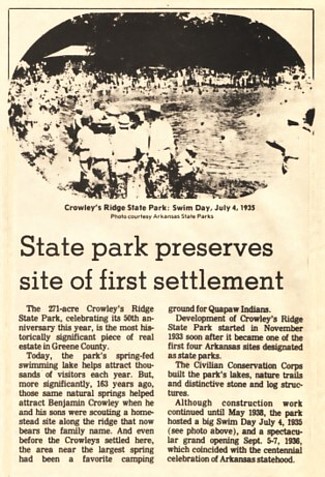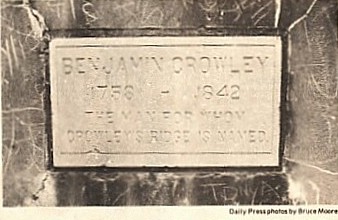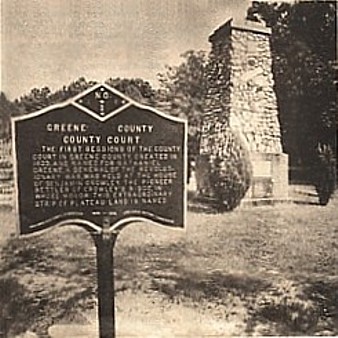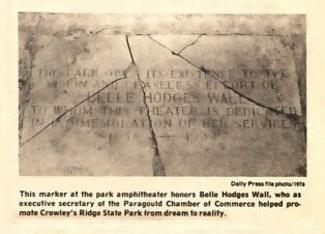Later pioneers found Ben Crowley's ridge 'good enough' too
| "This is good enough,"
the 63-year- old Benjamin Crowley is said to have told his sons in the summer of 1821. What was "good enough" was the site of the first white settlement in Greene County -- a place where the soil showed good prospects for cultivation, where abundant game assured a family's susten-ance, where numerous springs provided a refreshing and reliable water supply, where abundant timber promised sturdy homes. The land, part of the new Territory of Arkansas that had been created when Missouri achieved statehood in 1819, was a portion of the huge Louisiana Purchase that had been acquired by the United States from France only 16 years earlier. Land grants in the new region were offered by the government to military veterans, both as a payment for services and an inducement to settlement. Ben Crowley, a surveyor, was among those veterans staking his claim in the new land. Born in Virginia and raised in Georgia, he had made his way west to Kentucky by 1810. In about 1819, he and his large family crossed the Mississippi and traveled through Missouri to Arkansas, down the west side of Black River along the only mail route then in the state, which ran from Arkansas Post to St. Louis. The family stopped near Davidsonville and settled along the Spring River to plant a crop. From there, a small party went to the southeast, following an Indian trail that led to the Mississippi River, crossing the Black River and then the Cache before encountering a ridge of high ground. It was on this ridge that Crowley found the land he thought was "good enough." After resting for the night, Crowley and his sons returned to the Spring River country. While the father remained to oversee the harvest, the sons and several slaves returned to the ridge land to build shelters and prepare for the coming of the rest of family, who arrived on Christmas Day. The original Crowley land grant had been disrupted by the New Madrid earth- quakes of 1811-12, a series of powerful tremors which changed the landscape of northeast Arkansas, creating sunkenlands and swamps that slowed the development of this region. So the Crowleys instead chose land on the ridge that bear the family name. Ben Crowley's land claim near what is now Walcott is said to have been the first filed after the U.S. Land Office located a post at Batesville in 1820. The site Crowley chose had been a favorite camping ground for Quapaw Indians because of the big spring. Crowley permitted the peaceful Indians to continue camping on the plantation as they wished. Several stone hammers, great quantities of arrow-heads and other Indian relics were found in and near the park by CCC crews when Crowley's Ridge State Park was being constructed on the old Crowley homestead site. Like many who would follow them, the Crowleys had made their way west from the original southern states, coming from |
This stone nobelisk pictured below is said to mark the grave of Benjamin Crowley, the first settler in what is now Greene County and one of the men instrumental in its creation. Erected about 50 years ago when Crowley's Ridge State Park was first developed, it is located on a hill immediately behind the bath house. The monument and a nearby marker pay tribute to the man for whom the ridge and the park were named. Crowley and his family homesteaded the park site in 1821. Above, a closeup of the monument legend.
***=================================*** Virginia to Kentucky and then into Arkansas by
way of Missouri. |

| The 271-acre Crowley's Ridge State Park, celebrating
its 50th anniversary this year, is the most historically
significant piece of real estate in Greene County. Today, the park's spring-fed swimming lake helps attract thousands of visitors each year. But, more signif-icantly, 163 years ago,those same natural springs helped attract Benjamin Crowley when he and his sons were scouting a homestead site along the ridge that now bears the family name. And even before the Crowleys settled here, the area near the largest spring had been a favorite camping ground for Quapaw Indians. Development of Crowley's Ridge State Park started in November 1933 soon after it became one of the first four Arkansas sites designated as state parks. The Civilian Conservation Corps built the park's lakes, nature trails and distinctive stone and log struc- tures. Although construction work continued until May 1938, the park hosted a big Swim Day July 4, 1935 (see photo above), and a spectacular grand opening Sept. 5-7, 1936, which coincided with the centennial celebration of Arkansas statehood.
|
Above left Daily Press photos by: Bruce Moore


